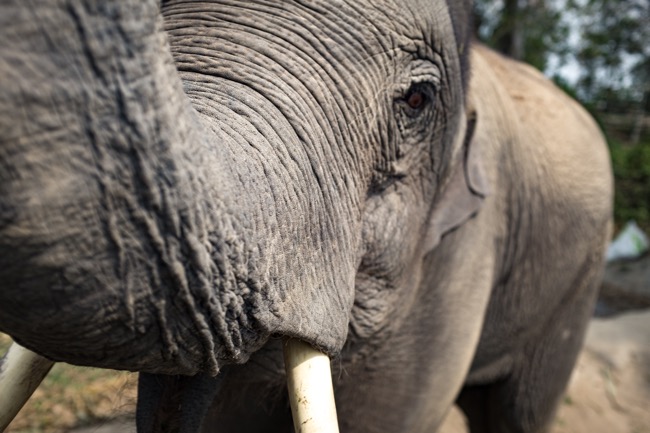
Many people are in awe when seeing an elephant up close. Who wouldn’t be? Just looking at these marvelous creatures alone is a sight to behold and it’s an experience many tourists yearn for. Some even wish to ride elephants as part of their all-too-familiar bucket list. Elephants are amazing creatures and the unfortunate thing is, many people are unaware of their plight in the tourism industry.
You may be surprised as to why some travelers swear against elephant trekking and suggest visiting an elephant sanctuary instead. Is there a valid reason behind this? What’s the difference between elephant sanctuaries and elephant trekking? In this article, we’ll be answering those questions and find out which activities are the most ethical from a tourism standpoint.
What is elephant trekking?
Elephant trekking is a popular tourism activity in many Southeast Asian countries such as Thailand, Malaysia, Cambodia, and more. Here, tourists are offered to ride on an elephant’s back and go on a trek while marveling at the views and surroundings that Mother Nature has to offer. While elephant riding may sound like an exhilarating experience for most travelers, for elephants, not so much.
Elephant trekking is a main attraction amongst tourists and it’s one of those activities that have long been a part of everyone’s bucket list. But in recent years, elephant trekking has caught plenty of flak and tour operators are no longer promoting it as part of their services. The reason being? It’s an unethical form of tourism that only amplifies the plight of Asia’s captive elephants.
Why is elephant trekking considered unethical?
You see, the spines of an elephant aren’t built to carry too much weight. Despite being large animals, their spines are relatively weak and even the weight of a single human being can cause premature spinal injuries. These problems are further amplified with a howdah (elephant seat) that’s strapped around the elephant’s back, adding even more load to their already vulnerable backs.
The seat straps rub on the elephant’s skin and cause blisters that become infected. What’s even worse is that the elephant’s feet suffer from excessive wear and tear due to long, arduous hours of trekking. Their health is neglected in exchange for business tactics that are downright unscrupulous for many animal welfare activists.
Perhaps the worst thing about elephant trekking is how the animals are treated. These animals undergo a cruel process called phajaan where they are deprived of their basic necessities in order to become docile and trainable. The baby elephants are separated from their mothers at an early age and are kept in cages where they are shackled and beaten with bullhooks. This brutal training method also applies to elephants who perform in street shows, circus acts, and other unconventional activities that the animals get involved in. Phajaan essentially breaks the spirit of the animals to where they become submissive to the every whim of their masters.
As more and more tourists discover the horrific truth behind elephant trekking, many tourists and tourist operators have begun taking their stance. Plenty of travel organisations no longer include elephant trekking as part of their services and are doing their best to inform the general public about ethical elephant tourism. This is where elephant sanctuaries come in which is deemed as the most ethical means of elephant interaction.
What are elephant sanctuaries?
Elephant sanctuaries are safe havens for rescued elephants who’ve endured brutal treatment as a result of unethical tourism. Here, the retired elephants receive complete medical care and attention where they can fully recover from all the injuries they’ve sustained. The animals are also protected from future harm and live in a semi-wildlife environment where they can roam around freely and interact with other elephants.
What differentiates an elephant sanctuary from elephant trekking is how the animals are treated. Elephant sanctuaries do not promote any kind of unethical tourism activities such as elephant riding, circus stunts, street walks, and more. Tourists get to observe the elephants in a safe and sometimes, even bathe and feed them. The animals have freedom to roam around the sanctuary, bathe in nearby ponds and rivers, and have their health closely monitored by experienced elephant veterinarians.
Each sanctuary offers a unique experience for tourists to interact with the elephants, all without inflicting harm on their health. Some sanctuaries even have volunteer projects where you can participate in and help improve the situation of captive elephants across Asia.
Why should you consider visiting an elephant sanctuary?
If you’re looking for an ethical and responsible way of interacting with elephants, you should consider visiting an elephant sanctuary. You get to be apart of a completely unique elephant experience and have an opportunity to promote responsible tourism around the places you visit like what Trunk Travel is promoting . In addition to that, you can also show your support by donating or participating in volunteer acts to further strengthen the cause of conserving one of nature’s most beautiful creatures. Elephant sanctuaries are a viable alternative to elephant trekking and their differences are far and beyond in terms of ethical elephant practices.
As a responsible tourist, it’s your job to research the activities that you’re participating in. Hopefully with the information provided here, you’ll be able to make an informed decision about which elephant activities that you should and shouldn’t consider. While most elephant sanctuaries operate in an ethical manner, it’s still wise to do a background check to avoid fake sanctuaries that lure in unsuspecting tourists.

Follow itravelnet.com